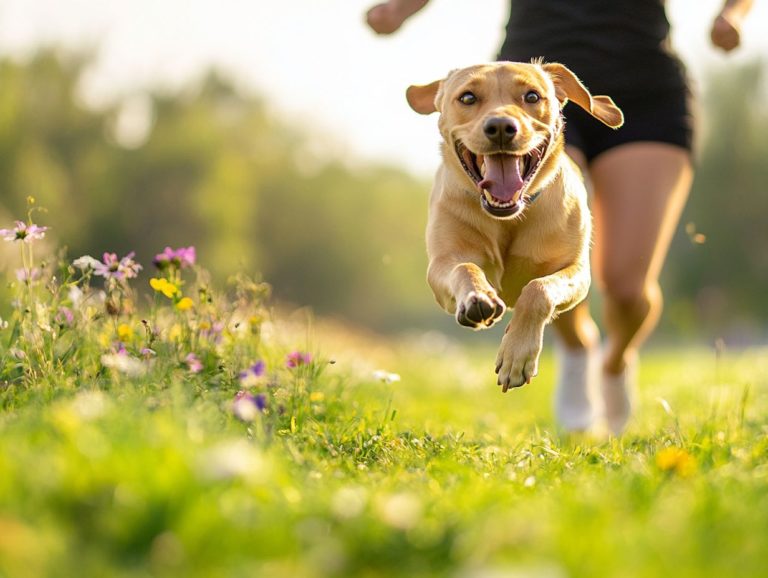Signs Your Pet May Be Experiencing Anxiety
Pets, much like humans, can experience anxiety. Understanding this issue is essential for their well-being.
By identifying common causes and triggers, as well as recognizing physical and behavioral signs, you gain valuable insight into pet anxiety. This exploration covers specific anxiety disorders, such as separation anxiety and noise phobia, and discusses effective treatment options.
Engage with this knowledge to enhance your furry friend’s quality of life.
Contents
- Key Takeaways:
- Understanding Pet Anxiety
- Signs and Symptoms of Pet Anxiety
- Common Anxiety Disorders in Pets
- Addressing Pet Anxiety
- How to Prevent Anxiety in Your Pet
- Frequently Asked Questions
- What are some signs that my pet may be experiencing anxiety and separation anxiety?
- Can certain events or changes trigger anxiety in pets, including fear-related anxiety?
- Are there any physical signs of anxiety in pets, such as signs of cognitive dysfunction syndrome?
- Can anxiety in pets lead to health problems such as increased aggression or health decline?
- How can I help my pet if they are experiencing anxiety, and what are some effective management strategies?
- Can I prevent my pet from developing anxiety through proper socialization and training?
Key Takeaways:

- Various factors can cause pet anxiety, such as past traumas, changes in routine, and genetics.
- Physical and behavioral signs include excessive grooming and destructive behaviors.
- Separation anxiety and noise phobia can be managed with treatment and a calming environment.
Understanding Pet Anxiety
Understanding pet anxiety means recognizing the emotional and behavioral hurdles your dog faces. For deeper insights, check out what your vet wants you to know about anxiety. Factors contributing to their distress include fear of loud noises, separation from you, or age-related confusion.
As a pet owner, it’s crucial to identify the signs of anxiety. If you notice concerning changes, refer to what to do if your pet’s anxiety worsens and observe your dog’s body language and behavior to prioritize their emotional well-being.
Causes and Triggers
Causes and triggers of pet anxiety vary widely. Significant factors include separation anxiety, fear of loud noises, and socialization issues.
These challenges often stem from environmental influences, like a chaotic household, and individual past experiences that instilled lasting fears.
For instance, your pet may react adversely during thunderstorms due to terrifying sounds or previous traumatic events. Specific triggers, such as unfamiliar people or animals, can heighten anxiety, especially without proper socialization training.
Understand these factors to help reduce your pet’s anxiety. Implement effective training strategies to foster positive interactions, enhancing your pet’s quality of life.
Signs and Symptoms of Pet Anxiety
Recognizing signs of pet anxiety is essential for dog owners to ensure their companions receive the care they deserve. Look out for indicators like excessive barking, destructive behaviors, or withdrawal from social interactions.
Pay close attention to your dog’s body language, including signs of fear or aggression. Being vigilant allows you to provide the comforting support your pet needs.
Physical and Behavioral Indicators

Dogs show anxiety through various physical and behavioral indicators. Signs can include a tucked tail, lowered ears, or avoidance behavior, all of which signal discomfort or fear. It’s important to recognize these signs to avoid the dangers of ignoring pet anxiety.
These physical signs often pair with behavioral cues like excessive licking, chewing, or ways your dog tries to feel better, revealing the emotional turmoil your dog may be enduring.
Recognizing these indicators is essential, as they frequently point to underlying emotional stress that requires attention. If your dog is experiencing anxiety, you may observe behaviors such as pacing, panting, or hiding, all suggesting a heightened state of alertness or vulnerability. Understanding anxiety triggers in pets can help address these issues effectively.
Understanding these behaviors enables you to implement effective management strategies tailored to your dog’s needs. This may involve creating a safe haven, engaging in calming activities, or seeking professional assistance. By observing and interpreting these signs, you strengthen the bond with your pet and promote their overall well-being.
Common Anxiety Disorders in Pets
Common anxiety disorders in pets can significantly affect their quality of life. Conditions like separation anxiety, noise phobia, and resource guarding are especially common in dogs.
You might observe these disorders manifesting in various ways, such as excessive barking or destructive behaviors when they’re left alone. If these issues are not addressed, they can escalate over time.
Gaining a deeper understanding of these disorders is crucial for crafting effective treatment strategies that cater to the unique needs of each dog.
Separation Anxiety, Noise Phobia, and More
Separation anxiety and noise phobia are among the most prevalent anxiety disorders in dogs, each with its own unique triggers and treatment options.
Understanding these conditions is crucial for effective management. You might notice separation anxiety in your dog through behaviors like chewing, digging, or having accidents indoors. They may also seem overly clingy. Common triggers can include changes in routine, moving to a new home, or even just a brief departure from your side.
Conversely, noise phobia can manifest as trembling, hiding, or destructive behavior when thunderstorms roll in or during fireworks displays. Treatment options often involve behavioral modification techniques, such as gradually desensitizing your dog to the feared stimuli and using positive reinforcement training.
You might also consider calming products like pheromone diffusers or anxiety wraps to help soothe their nerves. It’s essential to talk to your veterinarian right away to explore the best solutions, including potential medication that can enhance your approach.
Addressing Pet Anxiety
Addressing pet anxiety effectively requires a thoughtful blend of treatment options and strategies tailored specifically to your dog’s unique needs. Use positive reinforcement and behavior modification techniques.
Collaborating closely with veterinary experts will help you determine the most suitable course of action. This may integrate various training methods, anti-anxiety medications, or even nutritional supplements such as CBD oil.
Fostering effective communication between you and your pet is crucial in creating a calm and supportive environment that promotes their well-being.
Take steps today to ease your pet’s anxiety and improve their quality of life!
Effective Treatment Options for Your Dog s Anxiety

A range of treatment options awaits you for addressing your dog s anxiety. These include medication, training, and methods to reduce fear. Consider anti-anxiety medications prescribed by veterinarians, along with complementary treatments like CBD oil or nutritional adjustments to enhance overall wellness.
Training methods rooted in positive reinforcement can play a pivotal role in helping anxious dogs develop effective coping mechanisms.
Additionally, behavioral interventions such as gradual exposure and counterconditioning a method to change an animal’s response to a trigger are essential for reshaping your dog s anxious reactions to specific triggers. Establishing consistent routines can greatly enhance your dog s sense of security and predictability, enabling them to navigate their surroundings with greater confidence.
Engaging in wellness practices, like regular exercise and socialization, can significantly reduce anxiety levels. Collaborating closely with a professional trainer or veterinary behaviorist is vital to ensure that both medication and behavioral strategies work harmoniously for optimal anxiety management.
How to Prevent Anxiety in Your Pet
Preventing pet anxiety begins with crafting a serene environment and establishing a consistent routine that caters to your dog s emotional and physical needs. By incorporating regular exercise, mental engagement, and balanced nutrition, you can effectively lower your pet’s stress levels and foster their emotional well-being.
Understanding canine behavior and body language helps you support your dog better and fine-tune your approach to prevent anxiety-related challenges.
Creating a Calming Environment and Routine
Creating a calming environment for your dog is essential for minimizing anxiety and fostering emotional well-being. Designate a safe space where your dog can retreat during stressful moments. Incorporate regular exercise along with structured daily activities to add predictability to their life.
Engaging in interactive play and bonding time enhances companionship, significantly improving your dog’s overall sense of security.
To elevate this nurturing atmosphere, consider utilizing calming aids such as soft bedding, familiar toys, and even gentle music to soothe your furry companion. Establishing a consistent daily schedule for feeding, walks, and playtime provides your dog with the stability they crave, effectively easing anxiety.
By offering positive reinforcement during training sessions, you not only encourage good behavior but also strengthen the bond between you and your dog. Ultimately, these thoughtful considerations cultivate a peaceful environment, allowing your dog to thrive both emotionally and behaviorally.
Frequently Asked Questions
What are some signs that my pet may be experiencing anxiety and separation anxiety?

Some common signs your pet needs help with anxiety include excessive barking or meowing, destructive behavior, changes in appetite, shaking or trembling, and hiding or avoiding interaction with you.
Yes, just like humans, pets can experience anxiety in response to certain events or changes in their environment. Examples include moving to a new home, a change in routine, or the addition of a new pet or family member. Understanding your pet’s anxiety, including its causes and solutions, can help you provide the support they need. For more information, check out understanding your pet’s anxiety.
Are there any physical signs of anxiety in pets, such as signs of cognitive dysfunction syndrome?
Yes, some physical signs of anxiety in pets may include pacing, panting, increased heart rate, dilated pupils, or excessive grooming. To learn more, check out the signs of chronic anxiety in pets.
Can anxiety in pets lead to health problems such as increased aggression or health decline?
Yes, chronic anxiety in pets can lead to a weakened immune system and increase their risk of developing certain health problems, such as digestive issues or skin conditions.
Let s create a happier, calmer dog together! Talk to your vet today for personalized advice!
How can I help my pet if they are experiencing anxiety, and what are some effective management strategies?
The first step is to consult with your veterinarian to rule out any underlying medical conditions. Your vet may then recommend behavioral training, medication, or natural remedies.
Create a calm and safe environment for your pet. Ensure they get plenty of exercise and mental stimulation.
While there s no guaranteed way to prevent anxiety in pets, you can take steps to minimize their risk. Get your pet socialized early it’s a great way to keep them happy!
Maintain a consistent routine and address any potential stressors before they become a problem.






